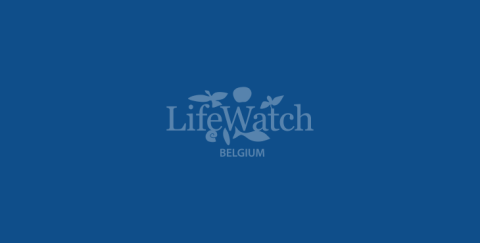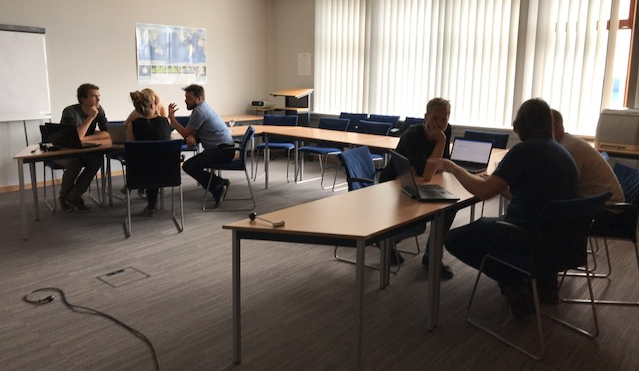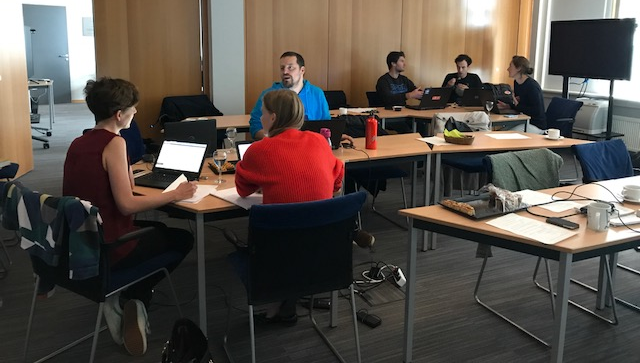LifeWatch Data Analysis Workshop: LifeWatch Cetacean passive acoustic sensor network
On October 5th-6th 2017, 14 experts met at the Flanders Marine Institute (VLIZ) in Ostend to explore and analyze the C-POD data generated by the Belgian LifeWatch Cetacean passive acoustic sensor network.

As part of the Belgian LifeWatch infrastructure, VLIZ is operating a passive acoustic hydrophone network to record the presence of harbor porpoises and dolphins in the Belgian part of the North Sea (BPNS).
Porpoises and dolphins (Odontoceti) use echolocation to extract information from their surroundings. Dolphins produce clicks in a wide frequency range and are typically short and loud while harbor porpoises are producing longer and weaker clicks in a narrow frequency range (120 - 145 kHz, mode 132 kHz). These clicks can be recorded by the passive acoustic device, C-POD (Chelonia Limited), when a marine mammal is swimming in the vicinity of the recorder. The C-POD can record clicks between 20 and 160 kHz including ambient background noise, sonar and other biotic underwater sound. The key to the performance of the C-POD is detection and classification of series of clicks, so-called click trains. Click trains have distinctive features which are used by the classification algorithms to identify the occurring cetacean species.
Currently, eight C-PODs are attached to buoys or anchored to ship wrecks or to artificial hard structures positioned along an east-west gradient covering coastal, midshore and offshore zones of the BPNS.
During day 1 of the workshop, an introduction was given to the LifeWatch Cetacean Passive Acoustic Sensor Network and the types of data generated by the C-PODs. Furthermore, the LifeWatch Data Explorer, and its features, was presented. Next, R scripts were presented for data preparation, mapping of the data, and graphical analysis of the data to determine the model (outliers, homogeneity, normality, collinearity, autocorrelation). During the remainder of day 1, several topics related to correlating the distribution of the harbor porpoises with (a)biotic variables were discussed in separate breakout groups, and new ideas and research questions were formulated to explore the next day.
During day 2, an overview was given of the results of the previous day and all participants worked on new ideas formulated the day before. The remainder of day 2 was spent on optimizing the spatial C-POD sensor network. Several topics were discussed in separate groups: (1) Continuous recording vs duty cycle, (2) Influence of quality score on output, (3) Number of stations needed to cover BPNS porpoise distribution, (4) How to deal with background noise, (5) Effect of bottom vs surface mooring, and (6) Aerial observations vs recorded underwater data.


Porpoises and dolphins (Odontoceti) use echolocation to extract information from their surroundings. Dolphins produce clicks in a wide frequency range and are typically short and loud while harbor porpoises are producing longer and weaker clicks in a narrow frequency range (120 - 145 kHz, mode 132 kHz). These clicks can be recorded by the passive acoustic device, C-POD (Chelonia Limited), when a marine mammal is swimming in the vicinity of the recorder. The C-POD can record clicks between 20 and 160 kHz including ambient background noise, sonar and other biotic underwater sound. The key to the performance of the C-POD is detection and classification of series of clicks, so-called click trains. Click trains have distinctive features which are used by the classification algorithms to identify the occurring cetacean species.
Currently, eight C-PODs are attached to buoys or anchored to ship wrecks or to artificial hard structures positioned along an east-west gradient covering coastal, midshore and offshore zones of the BPNS.
During day 1 of the workshop, an introduction was given to the LifeWatch Cetacean Passive Acoustic Sensor Network and the types of data generated by the C-PODs. Furthermore, the LifeWatch Data Explorer, and its features, was presented. Next, R scripts were presented for data preparation, mapping of the data, and graphical analysis of the data to determine the model (outliers, homogeneity, normality, collinearity, autocorrelation). During the remainder of day 1, several topics related to correlating the distribution of the harbor porpoises with (a)biotic variables were discussed in separate breakout groups, and new ideas and research questions were formulated to explore the next day.
During day 2, an overview was given of the results of the previous day and all participants worked on new ideas formulated the day before. The remainder of day 2 was spent on optimizing the spatial C-POD sensor network. Several topics were discussed in separate groups: (1) Continuous recording vs duty cycle, (2) Influence of quality score on output, (3) Number of stations needed to cover BPNS porpoise distribution, (4) How to deal with background noise, (5) Effect of bottom vs surface mooring, and (6) Aerial observations vs recorded underwater data.





